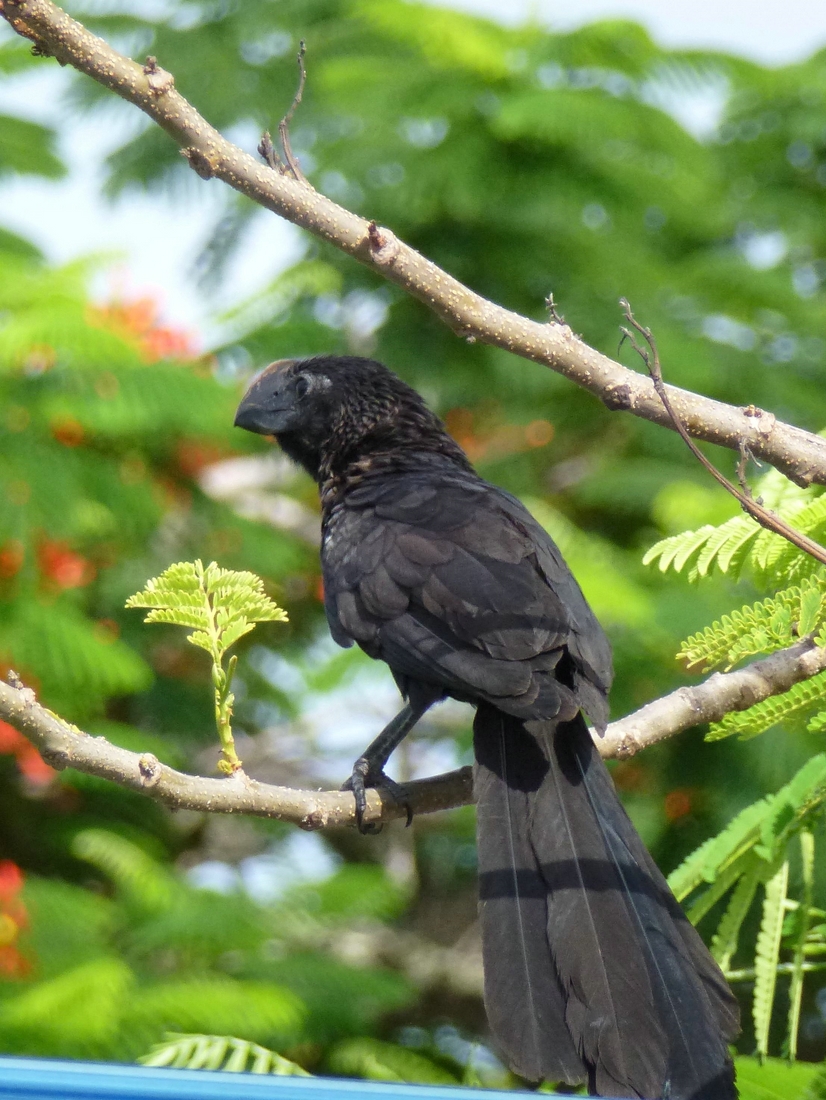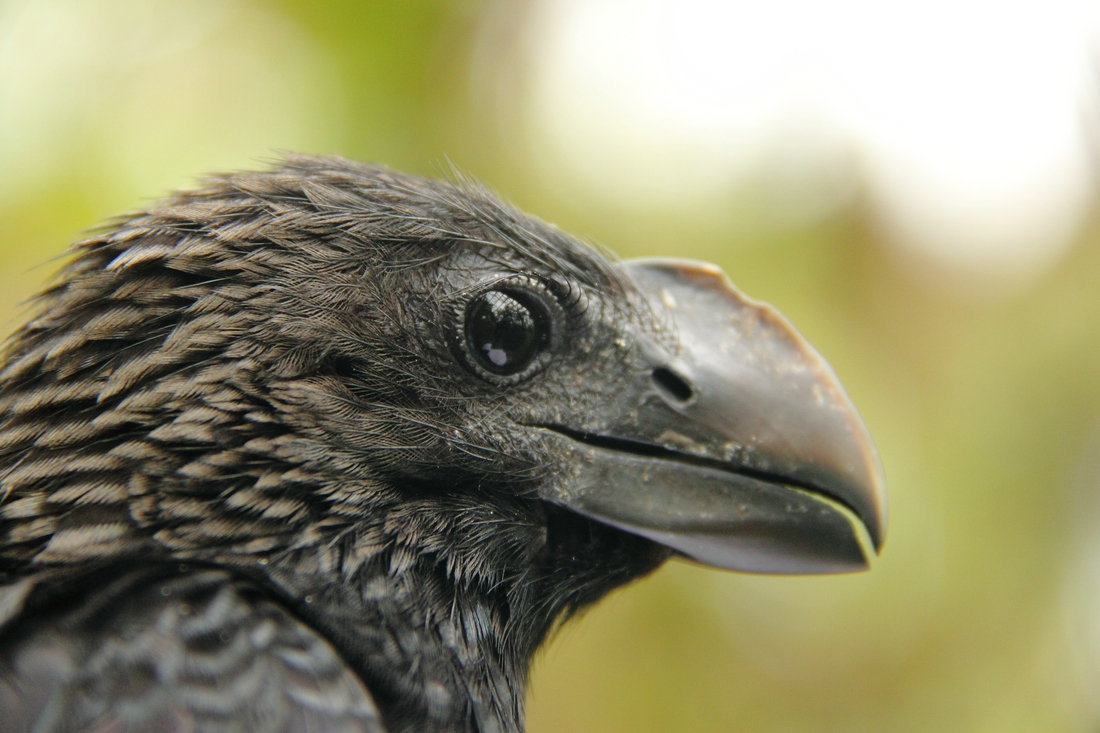Galapagos Species Database
The Galapagos Species Database shares the information about the species from our Natural History Collections.
Crotophaga ani
Garrapatero Piquiliso, Garrapatero, Ani, Garrapatero Pico liso, Pico machete., Smooth-billed Ani




It measures 30-3 6cm and weights some 100 g; males are slightly larger than females. Smooth-billed anis have an even black plumage with iridescent specles in neck and nape. The beak is laterally compressed, the culmen resembles a blade. Unlike other members of this genus, it does not have furrows or protuberances in the bill. Its wings are short and the tail is long. Legs, feet, beak and iris are black. Males and females look alike. Juveniles have dull blackish plumage, smaller and straight beaks (until approx. age of 9 month). Smooth-billed anis is social, forming groups that range in size from 8 to 25 individuals. Groups of up to 60 individuals have been registered for Galapagos. Smooth-billed anis has a complex vocal system including five different calls: contact, alarm, gathering, threat and high-pitch alarm.
The first recored was on Isabela in 1962, Santa Cruz in 1966 and Santiago in 1967. It has been recorded in other Islands. The results of eradication efforts on Marchena are not yet clear. When there is plenty of rainfall, the population increases.
Domain
Eukaryota
Kingdom
Animalia
Phylum
Chordata
Class
Aves
Order
Cuculiformes
Family
Cuculidae
Genus
Crotophaga
Species
ani
Taxon category: Accepted
Origin: Introduced - established
Year of first record: 1962
Year of introduction: 1962
Mode of introduction: Intentional
Introduction Pathway: Intentional
Subpathway: Release in nature for use
Introduced status: Naturalized
Invasive status: Invasive
Impact in Galapagos: It is considered the most damaging introduced bird for the ecosystems of the Galapagos Islands. C. ani represents a threat to native plants and birds. The population size of Smooth-billed anis is increasing at an alarming rate. In 2010, 80, 000 individuals were estimated to live on Santa Cruz with over 250, 000 Smooth-billed anis in Galapagos as a whole. In 2009 a study on the stomach contents of Anis in Santa Cruz showed that 98% of samples individuals had ingested invertebrates. A high percentage of the seeds ingested corresponded to Rubus niveus, a highly invasive plant. Also, remains of finch chicks were identified, a finding that shows that there is direct consumption of native birds. These findings confirm a high degree of threat of C. ani for the Galapagos Islands. The propagation of seeds of invasive plants by C. ani can affect the landscape of the islands. Their high preference for consumption of invertebrates adds pressure to native birds and invertebrates in the form of completion and depredation respectively.
Impact elsewhere: Not to be reported as a problem species elsewhere.
Control History in Galapagos: Since 1980 the Charles Darwin Foundation (CDF) has conducted studies to understand the species and identify eradication methods. Capture using live lures has been tried, traps, nets and culling using rifles. So far the most efficient method for hunting is using rifles. The Galapagos National Park Directorate is the only institution that currently carries out control of the species. The CDF in mid 2014 started a Land Bird project, a component of which is to identify an efficient strategy to control this species.
Control methods elsewhere: Culling using rifles, is so far the most efficient method to hunt Smooth-billed anis.
Known Pest elsewhere: Widespread on the tropics and sub-tropics.
Prevention options: Report immediately if new colonies are found in previously unreported sites. The competent authorities can thus cull and thus prevent further expansion of this species.
Preference for an altitude zone in Galapagos: Coastal zonera - humid zone
Habitat preferences: The species prefers open habitats, disturbed and human-altered agricultural zones, suburban areas including parks and second-growth forest. In Andean valleys it can be found up to 2800 masl. In Galapagos they can be found in all vegetation zones with highest numbers in the agricultural zone; during the cold periods of the year they group in the lower agricultural zone.
Feeding preferences: Feeds on insects in short to medium-length grass and forages opportunistically in trees and shrubs; picks berries from bushes. Often sentinel behavior while feeding. Smooth-billed ani is primarily insectivorous, in dry conditions the proportion of seeds increase. Their food preferences depend on the availability of food types in the areas where they live.
Trophic role: Omnivorous
Persistence mechanisms: The main characteristic that makes C. ani a persistent species is its ability to live in groups, where it shares feeding, roosting and nesting sites, including incubation and caring of the young. The communal breeding system is something uncommon among birds and might raise nesting success through input from various adult birds. Second broods are possible and depend on the food available. Young birds disperse in groups at age 8 to 12 month. They are food generalists showing a large array of insects, other invertebrates, small vertebrates, seeds and fruits. Outside the breeding season flocks of several groups can be found (up to 60 individuals observed in Galapagos). They are potential good fliers and some long-distance movement are known from the Americas.
Reproduction mode: Exclusively sexual
Reproductive biology: Smooth-billed ani constructs communal nests by all members of a group. The nest is large and deep cup-shaped. Every female can lay three to seven eggs; up to 7 females can lay in the same nest, sometimes burying the former eggs thus resulting in clutch sizes of 3 to 36 eggs. Only the top layer is incubated, resulting in up to 15 hatchlings. The eggs are green-blue. Incubation lasts 13-15 days. Incubation and chick rearing are shared tasks between the different pairs and other group members. A study conducted on Isabela Island in 1995 determined that anis begun reproduction in December and extended to July/August the following year. In the Galapagos Islands, smooth-billed anis nest in tree-canopies of thorny plants such as algarrobos, which often prevents direct observation. Breeding groups can produce three to four nests per year, depending on environmental conditions.
Distribution origin: Native bird to the Americas. It is distributed from Florida, Antilles including Trinidad y Tobago. From Costa Rica to the North of Argentina, Brazil, Ecuador and Peru. It is found from sea level to 2700 masl.
Distribution classification: Eutropical
Disease vector: Host of the lice (Vernoniella guimaraesi)
Map of specimen collection localities or observation records for this species in our collections database.
Distribution: Champion, Daphne, Fernandina, Floreana, Gardner, Genovesa, Isabela, Pinta, Pinzon, Plaza Sur, San Cristobal, Santa Cruz, Santiago.
- Ballesteros, N. (1984) Los garrapateros en la parte alta de la Isla Santa Cruz. High school thesis, Galapagos. Charles Darwin Research Station Library.
- BirdLife International (2012) Crotophaga ani. The IUCN Red List of Threatened Species. Version 2014.2. <www.iucnredlist.org>. Downloaded on 18 September 2014.
- Cooke, S. C. Haskell, L. E., Rees van C. B. & Fessl, B. (2019) A review of the introduced smooth-billed Ani Crotophaga ani in Galápagos. Biological Conservation 229: 38-49. https://doi.org/10.1016/j.biocon.2018.11.005
- Cooke, S. C. Anchundia, D., Caton, E., Haskall, L. E., Jäger, H., Kalki, Y., Molla, O., Rodriguez, J., Schramer, T. D., Walentowitz, A. & Fessl, B. (2020) Endemic species predation by introduced smooth-billed ani in Galápagos. Biological Invasions 22: 2111-2120. https://doi.org/10.1007/s10530-020-02251-3.
- Fessl, B. Tebbich, S. (2002) Philornis downsi - a recently discovered parasite on the Galápagos archipelago - a threat to Darwin's finches? Ibis 144: 445-451.
- Freile, J.F. Santander, T., Jiménez-Uzcátegui, G., Carrasco, L., Cisneros-Heredia, D., Guevara, E., Sánchez-Nivicela, M., Tinoco, B. (2019) Lista Roja de las aves del Ecuador Quito, Ecuador. 97 pp.
- Harris, M.P. (1973) The Galápagos avifauna. Condor 75(3): 265-278.
- Jiménez-Uzcátegui, G. Carrión, V., Zabala, J., Buitrón, P. & Milstead, B. (2007) Status of introduced vertebrates in Galapagos. Galapagos Report 2006–2007. Charles Darwin Foundation, Puerto Ayora, p. 136–141.
- Jiménez-Uzcátegui, G. Betancourt, F. (2008) Avifauna vs automotores. Informe Galápagos 2007-2008. FCD, PNG & INGALA. Puerto Ayora, Ecuador. p. 111–114.
- Patry, M. (2002) Estatus de vertebrados introducidos en las islas mayores de Galápagos y estrategias de manejo. En: Fundación Natura: Informe Galápagos 2001-2002. Quito, Ecuador.
- Phillips, R. B. D.A. Wiedenfeld and H.L. Snell (2012) Current status of alien vertebrates in the Galápagos Islands: invasion history, distribution, and potential impacts. Biol Invasions (2012) 14:461–480 DOI 10.1007/s10530-011-0090-z
- Quinn, J. S. Startek-Foote, J.M. (2000) Smooth-billed Ani (Crotophaga ani), The Birds of North America Online (A. Poole, Ed.). Ithaca: Cornell Lab of Ornithology; Retrieved from the Birds of North America Online: http://bna.birds.cornell.edu/bna/species/539 Accessed: 20 Jul 2014.
- Rosenberg, D.K Wilson, M.H., Cruz, F. (1990) The Distribution and Abundance of the Smooth-Billed Ani Crotophaga ani (L.) in the Galapagos Islands, Ecuador. Biological Conservation 51: 113-123.
- Soria, M. (2006) Avian seed dispersers of the invasive Rubus niveus (Rosaceae) in Santa Cruz Island, Galapagos, Ecuador. Masters Thesis, University of Missouri- St Louis.
- Tapia, W. Patry, M., Snell, H. & Carrión, V. (2000) Estado actual de los vertebrados introducidos a las islas Galápagos. Fundación Natura: Informe Galápagos 1999-2000. Quito, Ecuador.
- Wiedenfeld, D.A. (2006) Aves, the Galapagos Islands, Ecuador. Check List 2006 2(2): 1-27.
You are welcome to download and use the information found in this page, acknowledging its source.
This page should be cited as follows:
"Galapagos Species Database, Crotophaga ani", dataZone. Charles Darwin Foundation, https://datazone.darwinfoundation.org/en/checklist?species=5073. Accessed 2 January 2026.



Feeding type: Polyphagous
The species is omnivorous; its diet includes insects, spiders, centipedes and small vertebrates such as snakes, lizards, frogs, even bird chicks. Seeds, fruits and other plant material complete their diet. Although its common name in Spanish means “tick-eater”, very rarely they consume ticks or other ecto-parasites of cattle. In the Galapagos Islands they appear to have a predilection for wasps (Polistes versicolor) including their nests. This is the only known species that prey on these introduced wasps in Galapagos